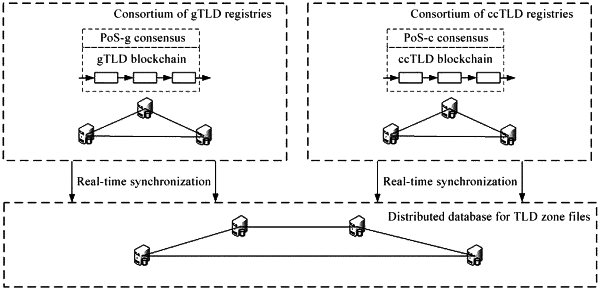| CPC H04L 9/30 (2013.01) [G06F 16/2315 (2019.01)] | 8 Claims |

|
1. A blockchain hybrid consensus-based system for maintaining domain name information, comprising:
a generic top-level domain (gTLD) blockchain, formed by first network nodes where international generic top-level domain registries are located; and a country code top-level domain (ccTLD) blockchain, formed by second network nodes where country code top-level domain registries are located;
wherein the blockchain hybrid consensus-based system comprises a computing device configured to:
collect, by a speaker node in consensus nodes of the gTLD blockchain, domain name operation information from each first network node, pack collected domain name operation information to generate first block information, broadcast the first block information to member nodes in the consensus nodes, receive verification result of each member node on the first block information, and send the first block information to each first network node to execute the domain name operation information in the first block information at each first network node in response to determining that a number of nodes by which the verification of the first block information passes in the consensus node is greater than a first preset threshold; and
collect, by a rotation node which currently takes turn in the ccTLD blockchain, domain name operation information from each second network node, pack collected domain name operation information to generate second block information, broadcast the second block information to each second network node, receive verification result of each second network node on the second block information, and send the second block information to each second network node to execute the domain name operation information in the second block information at each second network node in response to determining that the number of nodes by which the verification of the second block information passes is greater than a second preset threshold;
wherein the consensus node is the first network node that participates in the consensus process of verifying block information in the gTLD blockchain, and the consensus node includes the speaker node and the member nodes;
the blockchain hybrid consensus-based system is further configured to:
every time after each first network node executes the domain name operation information in the first block information or in response to detecting that the speaker node is not able to produce blocks, determine the consensus nodes for participating in the consensus process from the first network nodes of the gTLD blockchain according to a preset election mechanism, determine a unique node from the consensus nodes as the speaker node by a preset algorithm, and collect, by the speaker node, the domain name operation information from each first network node;
the determining the consensus nodes for participating in the consensus process from the first network nodes of the gTLD blockchain according to a preset election mechanism, determining a unique node from the consensus nodes as the speaker node by a preset algorithm comprising:
calculating election scores based on a number of tokens held and a holding time of tokens by each first network node, and according to a descending order of the election scores, taking the first network nodes ranked above a preset ranking as the elected consensus nodes for participating in the consensus process; and
selecting randomly a node from the consensus nodes, or determining a unique node based on a block height and a number of consensus nodes of the current gTLD blockchain, as the speaker node.
|